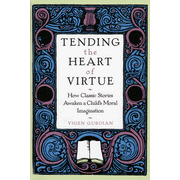In Tending the Heart of Virtue, Vigen Guroian reveals the depth of spiritual and moral messages packaged within some of the best children's literature. He opens with a discussion of how the analogies in stories can instill virtuous thoughts and ideas because of the strength of the pictures created within a child's imagination.
He continues with detailed analyses of Pinocchio; The Velveteen Rabbit; The Little Mermaid; The Wind in the Willows; Charlotte's Web; Bambi; The Snow Queen; The Lion, The Witch and the Wardrobe; The Princess and the Goblin; and Prince Caspian. The analyses are not presented in isolation, but under chapter headings focused on different moral ideas such as "Love and Immortality" and "Evil and Redemption."
You'll probably never again want to view another Disney version of a classic after you explore these original books. Did you realize that Pinocchio recapitulates "...the biblical motifs of drowning and rebirth and penance and baptism into new life"? At the end of his discussion of Pinocchio, Guroian sums up, "Thus, not through some final magical action is Pinocchio's transformation into a real boy accomplished, as Disney has it, but by the inner working of a grace that converts the heart and moves the self toward acts of real love" (p. 61). Movie viewers have no idea what they've missed in the "translation" to celluloid.
Tending the Heart of Virtue will make you impatient for opportunities to sit down and read these books with your own children. At the same time, it provides a sort of literary education for parents. Guroian is actually teaching us how to analyze literature as he walks us through these examples. You'll never read another children's book without looking for symbols and analogies that will help your child develop a virtuous heart.









